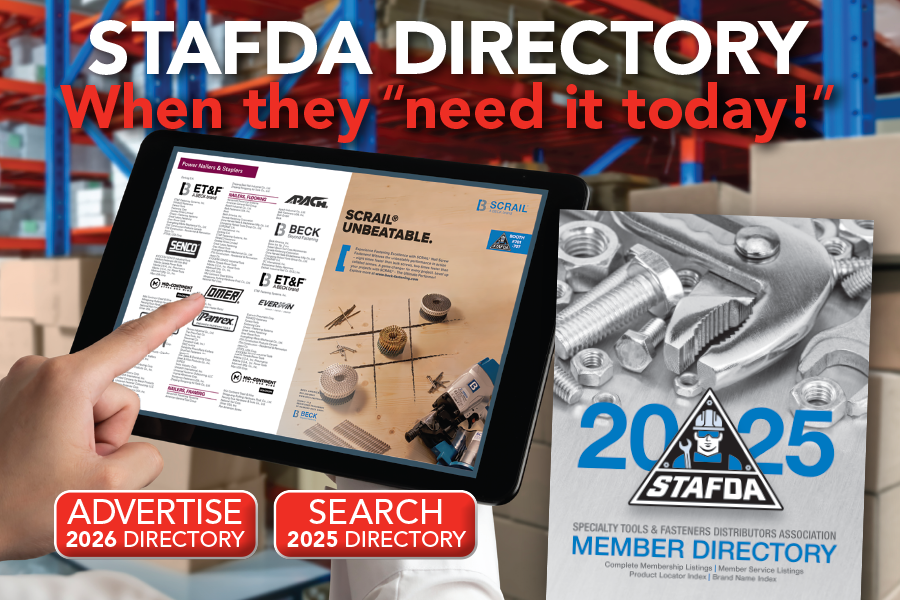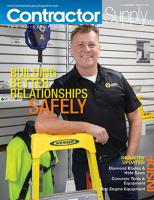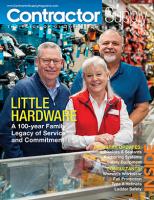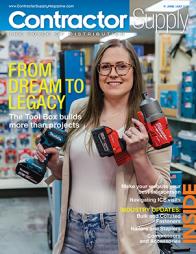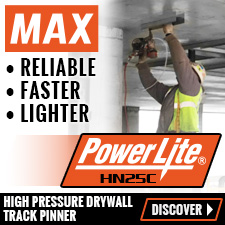Case Studies: Clinic’s architectural design goes beyond aesthetics to deliver cutting-edge life and safety
$221-million Hennepin Healthcare Clinic & Specialty Center is one of first large ambulatory designs to utilize life/safety photoluminescent egress markings under new 2015 Minnesota Building Code.
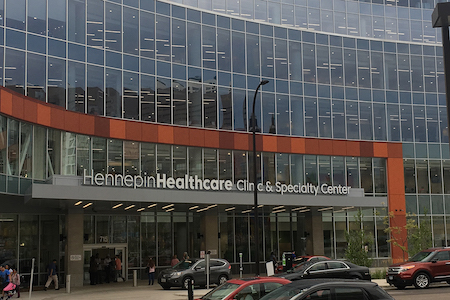 |
|
The $221-million Hennepin Healthcare Clinic & Specialty Center is one of first large ambulatory designs to utilize life/safety photoluminescent egress markings under new 2015 Minnesota Building Code. |
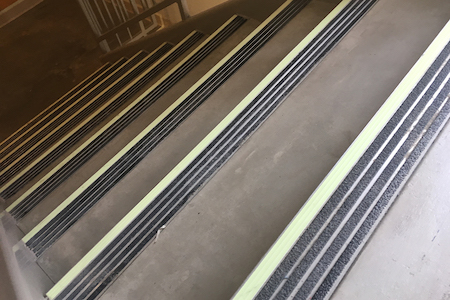 |
| The clinic’s five state-of-the-art stairwells showcases one of Minneapolis’ first life/safety specifications of PL egress path markings. |
 |
| Another life/safety design feature is the one-inch expansion joints between the free-floating second story skyway and the buildings it connects across 8th Street. Manufactured by Balco, the No Bump Series floor-to-floor mechanism expands/contracts from 50 to 100-percent and is protected with an aesthetic three-inch-wide stainless steel linear cover that also offers a seamless, solid walkway between the structures’ joint. |
Hennepin Healthcare Clinic & Specialty Center (CSC), a new $221 million marvel of clinic design in downtown Minneapolis, is lauded by both the general public and architectural critics for its aesthetic use of natural lighting, way-finding, convenience and use of life/safety photoluminenscent (PL) egress path markings.
Designed by 96-year-old architect firm BWBR, Saint Paul, Minn., CSC’s towering six-story-high glass facade and a 190-foot-long glass/steel skyway that stretches across 8th street to the Hennepin County Medical Center campus garner much of the visual attention.
The 327,000-square-foot facility is also expected to receive international recognition when awarded future Leadership in Energy and Environmental Design (LEED) certification. BWBR, a 160-employee design solutions firm with practices in architecture, interior design and master and strategic planning, applied for LEED Silver, but the project’s heralded green aspects may ultimately qualify it for Gold certification.
While the exteriors and interiors exhibit cutting-edge way-finding, natural lighting and convenience, lower profile areas such as the clinic’s five state-of-the-art stairwells showcases one of Minneapolis’ first life/safety specifications of PL egress path markings. The CSC’s stairwells use a variety of PL methods including IllumiTread 98 x 8-inch stair nosings supplied by Balco USA, Wichita, Kan., which manufactures a variety of PL-based egress products, such as stair nosings with embedded PL aluminum strips, PL aluminum strips for handrails and obstructions, PL signage, as well as life/safety fire-rated expansion joints for the facility.
Project general contractor/manager M.A. Mortenson Co., Minneapolis, installed the 3,000 linear feet of cast-in concrete stair nosings that protect the stairwells’ concrete stair edges from damage, help prevent slippage via a built-in abrasive tread surface, and provide PL illumination with embedded aluminum strips permanently coated with a rechargeable phosphorescent chemical.
The 2015 Minnesota Building Code (MBC) was enacted during the CSC’s design stage, thus the clinic is one of the first healthcare buildings to comply, according to Pete Haag, AIA, LEED AP, CDT, a BWBR senior job captain. Previously, PL was not code-mandated and was used only voluntarily in a handful of Minneapolis commercial building projects.
However, the CSC represents one of the first PL specification compliances under the MBC’s Section 1024—Chapter 10 Means of Egress, which was adopted from the Washington, D.C.-based International Code Council’s (ICC) 2012 International Building Code (IBC).
How Rechargeable PL Works
The stair nosings’ PL strips are energized continually by LED lighting and natural light from a wall of glass windows that span the entire height of the stairwells, the latter being another aesthetic BWBR feature not commonly found in high-rise stairwells.
According to the MBC, the PL is required to glow for a minimum 90 minutes when energized by 60-minutes of exposure from a minimum 11-lux light source as per test standards UL 1994 or ASTM E2072. In the event that power and emergency lighting fails, the stair nosings’ PL strips, combined with PL demarcation tape applied to all steel railings, handrails stair landings and exit doors outlines, will expedite safe occupant egress.
The PL treatment is equally important for first responder ingress safety (see Sidebar #1). This similar application was used in the former World Trade Center and was reportedly responsible for helping thousands of survivors exit the buildings before they collapsed on 9/11 (see Sidebar #2).
Typically stairwells in commercial high rises are barren structures; however the CSC stairwells’ plentiful outdoor light exposure purposely parallels the facility’s underlying theme of “natural light promotes healing,” as well as recharging the PL treatments. The natural light theme is incorporated into every aspect of BWBR’s architectural design from the stairwells to the expansive exterior glass façade curtain wall and large windows in patient rooms.
Many of these innovative treatments are also evident throughout BWBR’s extensive healthcare portfolio, which includes high profile projects such as Avera Prairie Center, Sioux Falls, S.D.; Mercy Medical Center—West Lakes, Des Moines, Iowa; and HealthPartners Neuroscience Center, Saint Paul.
Cutting Edge Stairwell Design
Other components of the all-concrete stairwells go well beyond a typical high rise building’s requirements. The stairwells also boast drywall and other aesthetic interior finishing features, such as color coding each floor for easy wayfinding.
“Most buildings don’t put much investment into stairwells, but the CSC design team wanted the stairwells to be inviting to employees and guests and designed it that way,” said Haag, who spearheaded a BWBR team for the CSC’s stairwells and exterior envelope architectural design.
Other Life/Safety Architectural Designs
Besides PL, another life/safety design feature is the one-inch expansion joints between the free-floating second story skyway and the buildings it connects across 8th Street. Manufactured by Balco, the No Bump Series floor-to-floor mechanism expands/contracts from 50 to 100-percent and is protected with an aesthetic three-inch-wide stainless steel linear cover that also offers a seamless, solid walkway between the structures’ joint.
Likewise, expansion joint assemblies are also employed in the skyway/building joint’s ceiling and walls with a stainless steel covers that match the doorway finish. The joint also includes Balco’s MetaBlock two-hour-rated firestop consisting of 2-1/2-inch-tall expansion foam with an internal intumescent layer that swells in the presence of extreme heat to prevent fire, smoke and toxic gas infiltration through the joint.
The CSC is a good example of how life/safety, wayfinding, convenience and even stairwells can be equally innovative as the highest profile features of a state-of-the-art healthcare facility. CS
SIDEBAR #1: Imperative PL Safety
- Aluminum PL strips have high durability; high longevity
- Aluminum PL strips are easy to clean & maintain
- Aluminum PL strips have high visibility
- PL is non-toxic, non-radioactive
- PL is charged by variety of light sources
- Abrasive in close proximity to PL is crucial to maintaining slip resistance
- Abrasive significantly lowers risk of falls and liability, both of occupants and emergency personnel
- Aluminum base protects stair nose from wear and/or damage
PL line is code-compliant and suitable for any stair application
SIDEBAR #2: 9/11 Attack Put Photoluminescent Specification in the Fast Lane
The 1993 World Trade Center underground parking garage bombing proved to building designers that emergency electrical lighting can be knocked out during catastrophes and a supplemental source of egress lighting was needed. Afterward, photoluminescent (PL) egress path marking, a quick-emerging technology at the time, was installed throughout in the World Trade Center.
The PL installation later proved invaluable for helping survivors see a pathway down darkened stairwells during the 9/11 terrorist attack in 2001.
Consequently, the United Nations installed PL in 2003 and New York City pioneered the trend toward PL during the passing of Local Law 26. Ultimately, the International Code Council (ICC) adopted PL provisions into the 2009 International Building Code (IBC) for certain building types under Sections 1022.9 Floor ID Signs and 1024 Egress Path Products.
Those milestones brought PL to the forefront of building life/safety and is gradually being instituted in local jurisdictions, such as the 2015 Minnesota Building Code’s adoption of recent IBC updates. Besides the IBC, other organizations are also including PL provisions, such as The National Fire Protection Association’s (NFPA) Life Safety Code and Building Construction and Safety Code.
The U.S. General Services Administration (GSA) also outlines PL for its Facilities Standards Buildings for the Public Buildings Service–Section 7.9 “Exit Path Markings.”
Balco, Wichita, Kansas, is a leading manufacturer of high performance construction products in the categories of expansion joints, stair nosings, mats/grids, trench/access covers, partition closures and photoluminescent egress systems. These products are specified by architects, engineers and contractors for commercial buildings. Established in 1957, steady growth over the years has been maintained through a commitment to providing high quality products and customer services that include customization, turnkey design and education/certification programs.
Balco is an ISO 9001-certified manufacturer with its own in-house UL test and research laboratory. Balco is a member of the American Institute of Architects (AIA), Construction Specification Institute (CSI), and International Concrete Repair Institute (ICRI). Balco is a portfolio company of CSW Industrials Inc., (NASDAQ GS:CSWI), a publically-traded company specializing in industrial products, coatings/sealants/adhesives, and specialty chemicals. For more information, visit www.balcousa.com, or call (800) 767-0082.




